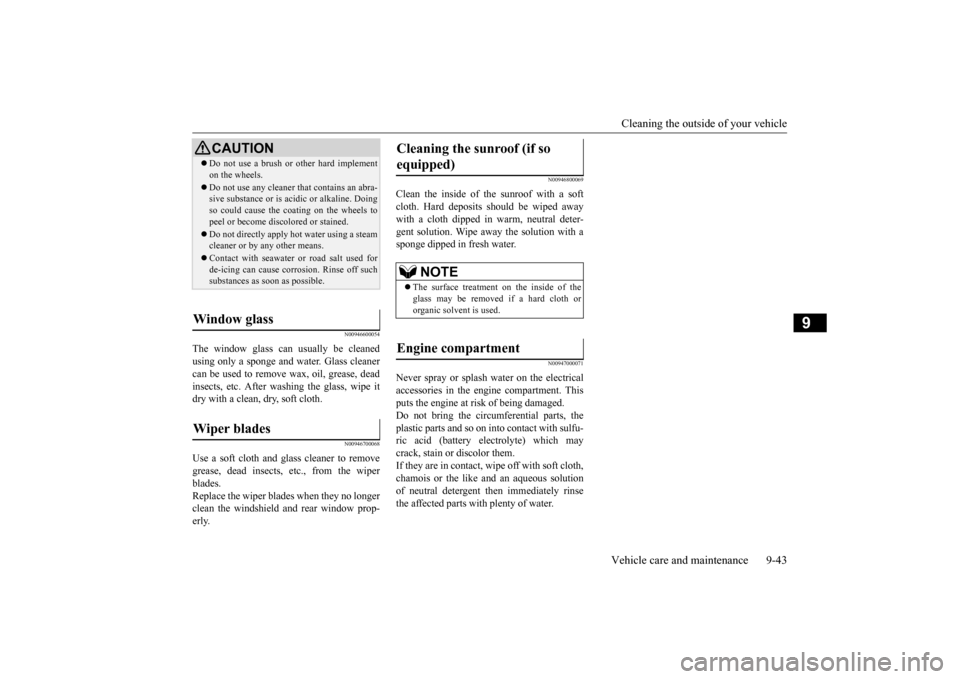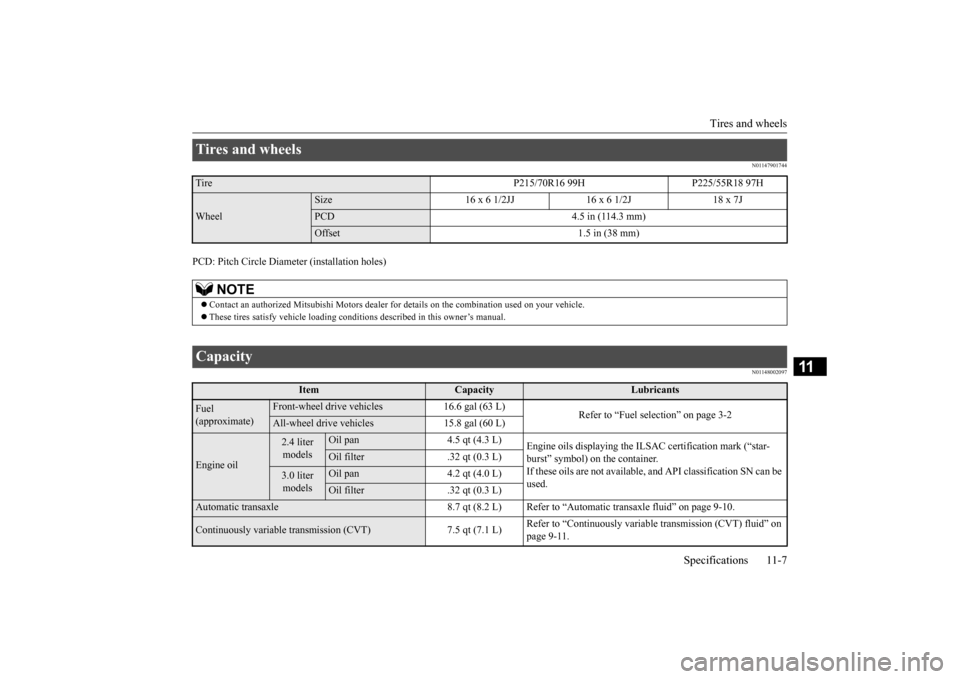Page 423 of 446

Cleaning the outside of your vehicle 9-42 Vehicle care and maintenance
9
N00946100046
If painted surfaces have
been severely dam-
aged and lost their original luster and color tone, polish the surface
lightly with a fine
polishing compound. Avoid limiting your polishing to the damage
d surface only; polish
a somewhat wider area, moving the polishingcloth in one direction.
After polishing, flush
the compound from the surface and apply a coat of wax to regain a beautiful luster.
N00946201099
Small cracks and scratches in the paint coat should be touched up as
soon as possible with
touch-up paint to prevent corrosion.Check body areas facing the road or the tires carefully for damage to the paint caused by flying stones, etc. The
paint code number for
your vehicle can be found on the vehicle information code plate located on the front passenger door sill.
N00946301221
Use a sponge or chamois to clean these parts.If the vehicle wax sticks to a gray or black rough surface of the bumper, molding or lights, the surface may appear white in color.In this case, wipe it
off using lukewarm water
and a soft cloth or chamois.
N00946400052
To prevent spots and corrosion of chrome parts, wash with water, dry thoroughly, and apply a nonabrasive automotive wax. If the chrome is severely da
maged or pitted, use a
commercially available chrome polish.
N00946500183
1. Remove dirt using a wet sponge.2. Use a mild detergent on any dirt that can- not be removed ea
sily with water.
Rinse off the detergent after washing thewheel. 3. Dry the wheel thoroughly using a chamois leather or a soft cloth.
Do not use gasoline, benzine, kerosene or paint thinners to remove
road tar or other dirt
from the vehicle surface. Do not put wax on the areas having black matte coating because
it can cause uneven
discoloration, patches,
blurs, etc. If these get
wax on them, wipe the wax off right away with a soft clot
h and warm water.
On vehicles with sunr
oof, be careful not to
apply any wax on the weatherstrip (blackrubber) when waxing the area around the sunroof opening. If stained with wax,
the weatherstrip cannot
maintain a weatherproof seal with the sun- roof.
Polishing
CAUTION
Damaged paint Cleaning plastic parts
CAUTION Do not use a scrubbing brush or other rough scrubber as these may
damage the plastic
surface. Do not use wax containing compounds (pol- ishing powder) which
may damage the plas-
tic surface.
Do not let plastic parts
get soiled with gaso-
line, oil, brake fluids
, engine oils, greases,
paint thinner, and sulfuric acid (battery elec-trolyte), as such substa
nces will cause stains,
cracks, or discoloration. If any of these get on a plastic part, wipethem up with a soft cloth or chamois and a mild solution of soap and water. Then rinse them immediately with water.
Chrome parts Aluminum wheels
(if so equipped)
CAUTION
BK0211800US.book 42 ページ 2014年3月12日 水曜日 午後2時42分
Page 424 of 446

Cleaning the outside of your vehicle Vehicle care and maintenance 9-43
9
N00946600054
The window glass can
usually be cleaned
using only a sponge and
water. Glass cleaner
can be used to remove
wax, oil, grease, dead
insects, etc. After washing the glass, wipe it dry with a clean, dry, soft cloth.
N00946700068
Use a soft cloth and gl
ass cleaner to remove
grease, dead insects, etc., from the wiperblades. Replace the wiper blades when they no longer clean the windshield and rear window prop-erly.
N00946800069
Clean the inside of the sunroof with a softcloth. Hard deposits
should be wiped away
with a cloth dipped in
warm, neutral deter-
gent solution. Wipe away the solution with a sponge dipped in fresh water.
N00947000071
Never spray or splash
water on the electrical
accessories in the engine compartment. Thisputs the engine at risk of being damaged. Do not bring the circum
ferential parts, the
plastic parts and so on
into contact with sulfu-
ric acid (battery electrolyte) which may crack, stain or discolor them. If they are in contact, wipe off with soft cloth,chamois or the like and an aqueous solution of neutral detergent th
en immediately rinse
the affected parts with plenty of water.
CAUTION Do not use a brush or other hard implement on the wheels. Do not use any cleaner that contains an abra- sive substance or is ac
idic or alkaline. Doing
so could cause the co
ating on the wheels to
peel or become disc
olored or stained.
Do not directly apply
hot water using a steam
cleaner or by any other means. Contact with seawater or road salt used for de-icing can cause corr
osion. Rinse off such
substances as soon as possible.
Window glass Wiper blades
Cleaning the sunroof (if so equipped)
NOTE
The surface treatment on the inside of the glass may be removed
if a hard cloth or
organic solvent is used.
Engine compartment
BK0211800US.book 43 ページ 2014年3月12日 水曜日 午後2時42分
Page 432 of 446
11
SpecificationsVehicle labeling ............................................................................. 11-2 Vehicle dimensions ........................................................................ 11-4 Vehicle weights .............................................................................. 11-5Engine specifications ..................................................................... 11-6 Battery ............................................................................................ 11-6 Tires and wheels ............................................................................ 11-7Capacity ......................................................................................... 11-7
BK0211800US.book 1 ページ 2014年3月12日 水曜日 午後2時42分
Page 433 of 446
Vehicle labeling 11-2 Specifications
11
N01147401749
Keep a record of the chassis number and vehicle identification
number. Such informa-
tion will assist police if
your vehicle is stolen.
1 - Vehicle emission control information labelThe vehicle emission control information label is affixed on the underside of the engine hood. 2 - Vehicle identification number plate The vehicle identification number is stamped on the plate riveted to the left front corner of the dashboard. It is visible from outside of thevehicle through the windshield. 3 - Air conditioning label
The air conditioning label is affixed on the inside panel of the engine hood. 4 - Vehicle information code plate The vehicle information code plate is locatedon the front passenger door sill.
The chassis number is stamped on the bulk- head as shown in the illustration.
Vehicle labeling
Chassis number
BK0211800US.book 2 ページ 2014年3月12日 水曜日 午後2時42分
Page 434 of 446
Vehicle labeling
Specifications 11-3
11
The engine serial num
ber is stamped on the
cylinder block as shown
in the illustrations.
N01148101613
The tire and loading information placard is located on the driver’s door sill. Ty p e 1
Ty p e 2
N01148201249
The certification label is located on the driver’s door sill.
Engine serial number * - Front of the vehicle2.4 liter models3.0 liter models
Tire and loading information placard
Certification label
BK0211800US.book 3 ページ 2014年3月12日 水曜日 午後2時42分
Page 437 of 446
Engine specifications 11-6 Specifications
11
N01147701511 N01147801293
Battery is a 12 volt type.Engine specifications
Item
2.4 liter models
3.0 liter models
Engine model 4J12 6B31Engine displacement 144.0 CID (2
,360 cm³) 182.9 CID (2,998 cm³)
No. of cylinders and cylinder arrangement Inline-4 60° V-6Bore 3.46 in (88.0 mm) 3.45 in (87.6 mm)Stroke 3.82 in (97.0 mm) 3.26 in (82.9 mm)Compression ratio 10.5Thermostat valve opening temperature 188.6 °F (87.0 °C) 179.6 °F (82.0 °C)Spark plugs
NGK DILKR6D11G DILKR7C11
Spark plug gap .040 to .043 in (1.0 to 1.1 mm) .040 to .043 in (1.0 to 1.1 mm)Firing order 1-3-4-2 1-2-3-4-5-6Battery
2.4 litter models 75D23L3.0 litter models 80D26L
BK0211800US.book 6 ページ 2014年3月12日 水曜日 午後2時42分
Page 438 of 446

Tires and wheels
Specifications 11-7
11
N01147901744
PCD: Pitch Circle
Diameter (ins
tallation holes)
N01148002097
Tires and wheels Tire P215/70R16 99H P225/55R18 97HWheel
Size 16 x 6 1/2JJ 16 x 6 1/2J 18 x 7JPCD 4.5 in (114.3 mm)Offset 1.5 in (38 mm)
NOTE
Contact an authorized Mitsubishi
Motors dealer for de
tails on the combinati
on used on your vehicle.
These tires satisfy vehicle loading condi
tions described in
this owner’s manual.
Capacity
Item
Capacity
Lubricants
Fuel (approximate)
Front-wheel drive ve
hicles 16.6 gal (63 L)
Refer to “Fuel selection” on page 3-2
All-wheel drive vehicles 15.8 gal (60 L)
Engine oil
2.4 liter models
Oil pan 4.5 qt (4.3 L)
Engine oils displayi
ng the ILSAC certification mark (“star-
burst” symbol) on the container. If these oils are not available,
and API classification SN can be
used.
Oil filter .32 qt (0.3 L)
3.0 liter models
Oil pan 4.2 qt (4.0 L)Oil filter .32 qt (0.3 L)
Automatic transaxle 8.7 qt (8.2 L) Refer to
“Automatic transaxle fluid” on page 9-10.
Continuously variable transm
ission (CVT) 7.5 qt (7.1 L)
Refer to “Continuously variable
transmission (CVT) fluid” on
page 9-11.
BK0211800US.book 7 ページ 2014年3月12日 水曜日 午後2時42分
Page 439 of 446
Capacity 11-8 Specifications
11
Transfer oil .50 qt (0.47 L)
Mitsubishi Motors Genuine Supe
r Hypoid Gear Oil API classi-
fication GL-5 SAE 80
Differential
Rear axle .42 qt (0.4 L)
Mitsubishi Motors Genuine Supe
r Hypoid Gear Oil API classi-
fication GL-5 SAE 80
Brake As required Conforming to Brake fluid DOT3 or DOT4Hood lock release mechanism and safety catch A
s required Multipurpose type
grease NLGI Grade 2
Engine coolant {Includes .69 qt (0.65 L) in reserve tank}
2.4 liter models 6.3 qt (6.0 L)
Mitsubishi Motors Genuine
Super Long Life Coolant
Premium or equivalent
*
3.0 liter models 9.5 qt (9.0 L)
Washer fluid 4.8 qt (4.5 L) —Refrigerant (air conditioning)
Refer to the “Air con- ditioning label” on
page 11-2.
HFC-134a
* :similar high quality ethylene
glycol based non-silicate, non-amine, non-nitrate
and non-borate coolant with long life hybrid o
rganic acid tech-
nology
Item
Capacity
Lubricants
BK0211800US.book 8 ページ 2014年3月12日 水曜日 午後2時42分